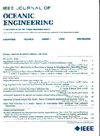Spotlighting on Objects: Prior Knowledge-Driven Maritime Image Dehazing and Object Detection Framework
IF 5.3
2区 工程技术
Q1 ENGINEERING, CIVIL
引用次数: 0
Abstract
Maritime environments often face visibility challenges due to haze which significantly impacts detection models. However, existing maritime object detection algorithms often neglect haze conditions or the unique characteristics of the maritime environment, resulting in decreased effectiveness in hazy weather. In this article, we propose a prior knowledge-driven maritime image dehazing and object detection framework (MDD), which consists of a detection network and a restoration network. Leveraging the characteristics of the highlighted ships in the inverted dark channel prior (IDCP), the detection network incorporates a prior subnetwork to learn ship-related features, which are subsequently merged into the backbone network through an IDCP cross-attention module. During training, the restoration network is integrated to improve the clarity of the features learned by the detection network. In addition, a ship-haze enrichment strategy is implemented to emphasize ship regions in the training samples, along with a ship-aware reconstruction loss to enhance the network's ability to learn dehazed features. Moreover, we establish a maritime object recognition with haze levels (MORHL) data set to evaluate object detector performance in maritime hazy conditions. It includes 13 280 annotated images across six categories: cargo ship, container ship, fishing boat, passenger ship, island, and buoy, with haze levels categorized as light, medium, and heavy. Comprehensive experiments on the MORHL and SMD data sets demonstrate that the proposed MDD framework outperforms the state-of-the-art detectors and various combinations of dehazing and detection methods.目标聚焦:先验知识驱动的海洋图像去雾和目标检测框架
由于雾霾,海洋环境经常面临能见度挑战,这对探测模型产生了重大影响。然而,现有的海上目标检测算法往往忽略了雾霾条件或海洋环境的独特性,导致在雾霾天气下的有效性下降。本文提出了一种先验知识驱动的海洋图像去雾和目标检测框架(MDD),该框架由检测网络和恢复网络组成。利用反转暗通道先验(IDCP)中突出显示的船舶特征,检测网络结合先验子网络来学习船舶相关特征,随后通过IDCP交叉关注模块将这些特征合并到骨干网络中。在训练过程中,结合恢复网络,提高检测网络学习到的特征的清晰度。此外,采用船舶雾霾富集策略来强调训练样本中的船舶区域,同时采用船舶感知重构损失来增强网络学习去雾特征的能力。此外,我们还建立了基于雾霾水平的海上目标识别(MORHL)数据集,以评估海上雾霾条件下目标检测器的性能。它包括13 280张带注释的图像,分为货船、集装箱船、渔船、客船、岛屿和浮标6类,雾霾等级分为轻、中、重。在MORHL和SMD数据集上的综合实验表明,所提出的MDD框架优于最先进的检测器以及各种除雾和检测方法的组合。
本文章由计算机程序翻译,如有差异,请以英文原文为准。
求助全文
约1分钟内获得全文
求助全文
来源期刊

IEEE Journal of Oceanic Engineering
工程技术-工程:大洋
CiteScore
9.60
自引率
12.20%
发文量
86
审稿时长
12 months
期刊介绍:
The IEEE Journal of Oceanic Engineering (ISSN 0364-9059) is the online-only quarterly publication of the IEEE Oceanic Engineering Society (IEEE OES). The scope of the Journal is the field of interest of the IEEE OES, which encompasses all aspects of science, engineering, and technology that address research, development, and operations pertaining to all bodies of water. This includes the creation of new capabilities and technologies from concept design through prototypes, testing, and operational systems to sense, explore, understand, develop, use, and responsibly manage natural resources.
 求助内容:
求助内容: 应助结果提醒方式:
应助结果提醒方式:


